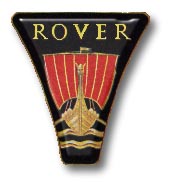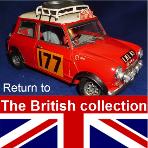
1959 Rover P5 3lt saloon
The Rover P5 ‘3-litre’ contradicted Rover's image and took the company into new territory in several ways. When the P5 was presented to the bosses at Rover one of them told designer David Bache.
“That’s a very beautiful model you’ve produced. I know everyone is most impressed with it. But we can’t make it, you know. And I’ll tell you why we can’t make it – it’s a head-turner and the Rover Company doesn’t make head-turners.”
Obviously they did make and it was the vision of Rover’s Chief Engineer Maurice Wilks to see that the company could make more profit from building a stylish large car to compete in the luxurious executive car market. The quote above clearly indicates what a struggle it was to get the design signed off by the board but once it went into production it proved to be a hit, eclipsing Rover's expectations. Even Her Majesty the Queen drove an Arden Green P5B carrying the registration “JGY 280” which had been on the first car given to her by her father, King George VI. This car is known to be a personal favourite of Her Majesty.
In another new direction for the company Rover used the P5 to enter the world of competition rallying in 1962, with some very positive results too.
The P5 was designed by David Bache, with engineering input from Spen King and Gordon Bashford, and was in production from 1958 until 1973, replacing the smaller P4 series. It had a straight-6 IOE 2,995cc engine with overhead intake valves and side exhaust valves, an unusual design carried over from the P4; power output was rated at 115bhp. Suspension was independent at the front by means of wishbones and torsion bars but at the back was still a live axle mounted via semi-elliptic leaf springs. 11-inch Girling brake drums were initially proposed for all four wheels but by the time of production Girling Disc brakes were fitted at the front to boost stopping power for this rather heavy car.
Automatic transmission was available alongside a manual gearbox with optional overdrive. An automatic version, costing £1864 including taxes, was tested by “The Motor” magazine in 1960 and found to accelerate from 0–60mph in 17.1 sec's achieving a top speed of 95.0mph, a little shy of Rover's claimed 98mph. Power steering by Burman was a popular option and from 1961 this became standard, a variable ratio hydrosteer power steering system becoming an upgrade option.
Amongst the buying public it was said that only the Bentley had a better interior. It was spacious and refined with leather and wood giving an air of luxury, and a strong emphasis on quality. The car was one of the last of the traditional British saloons meant for a more elegant, graceful, age of motoring.
The P5 went through three series as Rover continuously improved the car in an effort to distance themselves from the image that the car was almost exclusively for the older British gentlemen. The breakthrough came with the series three car and it's new 134bhp 3Ltr engine of 1965. This improved the performance of the car to the point where it was suddenly a more than suitable tool for getaway drivers bolting from the scene of the crime! But towards the end of the 1960s even this car was starting to show it's age and that was when a remarkable coincidence occurred that would bring the UK, and Rover, one of it's most famous and enduring engines.
Apparently Rover's MD, William Martin-Hurst, was visiting Mercury Marine in Wisconsin when a discarded Buick alloy 3.5-litre V8 engine was uncovered. He took the units measurements and, after some protracted negotiations with General Motors, Rover were able to purchase the tooling for the Buick 215. This became the basis, albeit with considerable amendments, for the 3.5-litre Rover V8 which went on to power some of the countries most famous vehicles for almost half a century.
From 1967 to 1973 Rover sold this engine in the P5, as the P5B (B for Buick) and really turned the model into a very stately car with a 0-60 figure that felt to 11.7 sec's and a top speed of 110mph. This despite the fact that the V8 only came with a three speed Borg Warner Type 35 automatic gearbox.
The P5B was now a genuine alternative to Mercedes and Jaguar. The lighter alloy engine block aided handling while the step up in power made the car much more sporty, something built upon by Rover with the addition of Rostyle sports wheels. All this saw Rover's original plan for a weekly output of 85 cars quickly outstripped.
A coupé version of all series was made available but even here Rover challenged the orthodox “two-door” coupé ideas by maintaining four doors. The roof was lowered by 2½ inches and the beautiful sloping back gave a very sleek look to the car. The look was further enhanced by a rectangular front quarter light and stainless steel window surrounds (rather than the painted ones of the saloon). Other distinguishing features include the rear quarter light now being part of the door and a brushed stainless steel panel behind the rear door which includes the “Long Ship” badge.
In 1968 British Motor Holdings merged with Leyland making Rover and Jaguar in house rivals and the outcome was pretty obvious to most observers. The board of the British Leyland Motor Corporation favoured Jaguar for the luxury executive car market and rover was returned to it's earlier role of not making head turners. Jaguar never looked back. However the last batch of the 69,141 P5s built were bought by the British government in 1973 and stored for official duties as and when required. In fact when Mrs. Thatcher arrived in Downing Street after her famous election victory, the car she was driven in was a 1972 P5B.
Despite the British Leyland decision the P5 series cars cemented themselves a place in the British psyche and have featured in numerous films including “The Life and Death of Peter Sellers” and “the Big Sleep” and TV shows like “Inspector George Gently” and of course “Top Gear” and “Wheeler Dealers”. Politicians Like Ted Heath and Jim Callaghan also drove P5s and the Admiralty Blue car owned by Harold Wilson had a specially designed ashtray for his pipe.
Today the Rover P5 is still an esteemed classic popular with collectors and devotees alike. Generally speaking the V8-engined cars are the preferred versions and the most desirable models are the 3.5 litre P5B Coupés; and who can blame the collectors when this model has all the looks as well as the power. Keeping the P5 series in the spotlight in the UK is a thriving Rover P5 club which holds regular rallies and meetings to promote this very popular car.





1/46th scale kit.
Built by Rod.




The Revell Cadet series of kits was produced to the rather unusual scale of 1/46th. The series one Rover P5 kit, kit # H-900, was one of several British cars in the range and most of them have never been released by anyone else in any scale. The kit was first released in 1962 and was Made in England. Moulded in black/grey plastic there was also a chromed sprue for the bumpers etc. The box even proudly displayed the words “with SILVER parts” on the front of the box. Another quirky sales item was the inclusion of a booklet on auto safety called “Nine lives”. These kits are now very very, rare and highly collectable.
Rod built this model way back in the early 1960s and it is painted by brush with Humbrol enamel paints. His recollections of building the model are that it was a nice kit for the time and certainly the chrome parts were a novelty back then. It doesn't look so good in today's world but remembering that time that has lapsed and the much simpler paints and tools of the time this is only to be expected.
RETURN TO :-
